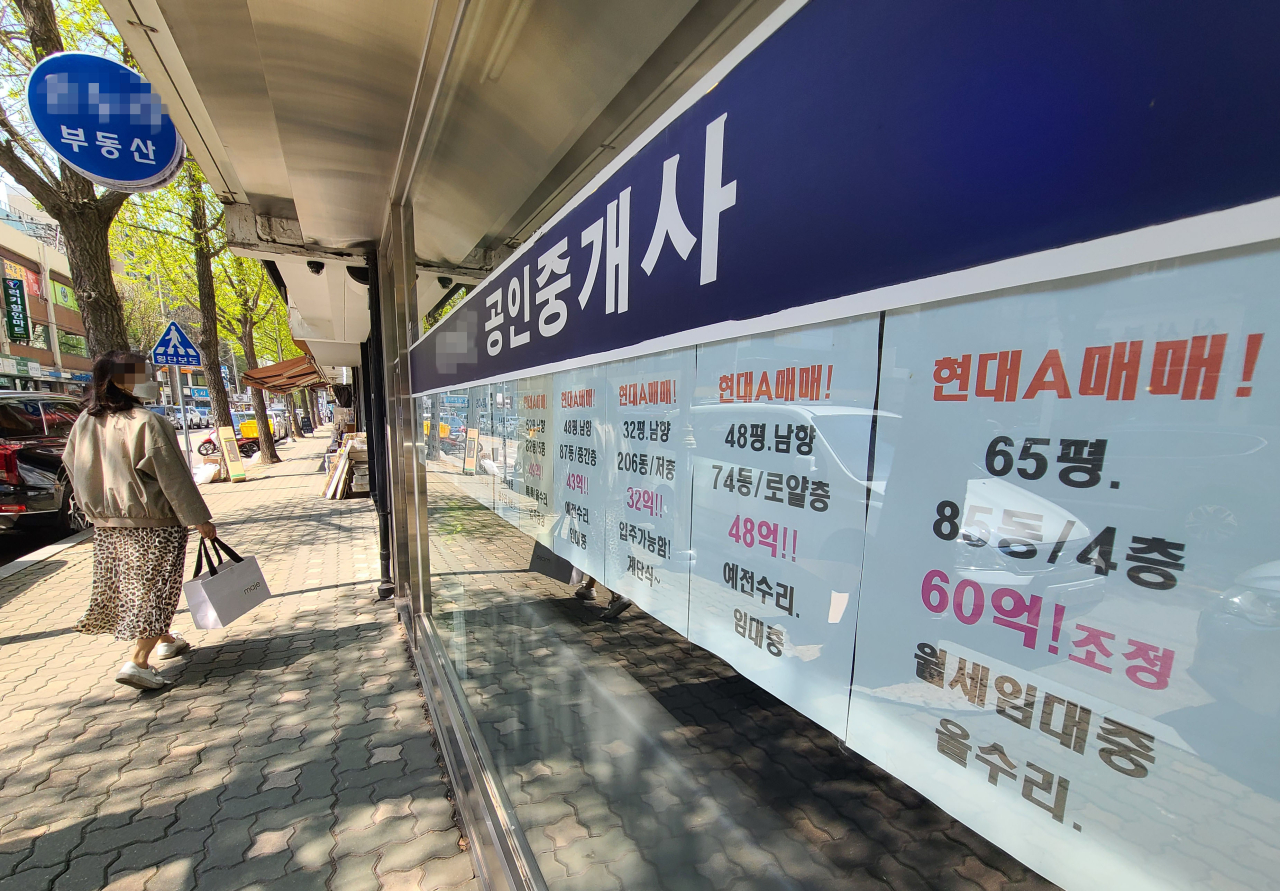
Postings on the window of a real estate agency in a location of the Gangnam district in Seoul show that asking prices from some apartment units are going for 100 million won ($89,000) per 3.3 square meters as of April 6. (Yonhap)
SEJONG -- Housing prices in the wealthy Gangnam area of Seoul were found to have shot up again in recent weeks, after spikes in prices in Seoul’s non-Gangnam districts and Gyeonggi Province’s major cities last year.
The Gangnam area generally refers to two districts -- Gangnam-gu and Seocho-gu – out of the 25 in the capital.
According to KB Kookmin Bank and Naver.com, the average trading price of homes, including apartments, in Gangnam-gu climbed by 6.1 percent from 59.3 million won ($53,100) per pyeong (3.3 square meters) on Oct. 30, 2020 to 62.93 million won ($56,400) on March 26, 2021.
Seocho-gu saw the average price reached 60.48 million per pyeong, up 6.8 percent over the corresponding period.
Over the five-month period, a more than 10 percent increase was posted in locations such as Gangnam’s Yangjae-dong at 12.2 percent and Apgujeong-dong at 10.1 percent and Seocho’s Umyeon-dong at 10.1 percent.

(Graphic by Kim Sun-young/The Korea Herald)
Seocho’s Banpo-dong outstripped Gangnam’s Apgujeong-dong in the average trading price of homes by 84.94 million won vs. 79.69 million won per pyeong.
This means that the average price of an 84-square-meter home (a popular size in Korea) in Banpo-dong would cost around 2.16 billion won. A same-sized flat in an apartment building in the same location is likely to cost more.
While Banpo-dong recorded a 9.1 percent climb, among the next on the list were 8.6 percent in Gangnam’s Sinsa-dong, 8 percent in Seocho’s Bangbae-dong, 7.5 percent in Seocho’s Seocho-dong and 5.7 percent in Seocho’s Jamwon-dong.
Alongside Banpo-dong and Apgujeong-dong, quite a high average price is seen in Seocho-gu’s Jamwon-dong at 72.76 million won per pyeong, Gangnam-gu’s Daechi-dong at 69.06 million won and Yeoksam-dong at 60.19 million won.
In a similar vein, a recent spike is seen in Songpa-gu, which is sometimes considered part of the Gangnam area, along with Gangnam-gu and Seocho-gu.
The average price in Songpa-gu increased 8.3 percent between Oct. 30 and March. 26 to 49.89 million won.
While Jamsil-dong topped the list in average trading price in Songpa with 65.57 million won per 3.3 square meters, locations such as Munjeong-dong and Garak-dong outstripped Jamsil-dong in growth by 9.8 percent vs. 6.4 percent.
Some real estate analysts share the view that the price growth in the Gangnam area is mainly attributed to growing hopes of reconstruction of old apartment complexes, built in the late 1970s and 1980s.
Market participants, including buyers of old apartments, are estimated to have bet on the winning of any Seoul Mayor candidate from the opposition parties on the April 7 by-election, while the previous mayor from the ruling Democratic Party of Korea had taken a skeptical stance over apartment reconstruction in the capital.
Newly elected Mayor Oh Se-hoon, from the main opposition People Power Party, has continued to express strong resolution toward housing reconstruction and land redevelopment. An issue is how the city would successfully coordinate with the Land Ministry over the housing supply policy.
Meanwhile, a core coming issue is whether the Moon Jae-in administration will carry out another round of “anti-speculation” policy, after dozens of real estate policies over the past four years failed to curb trading prices.
So far since 2017, the trading prices have jumped more than 100 percent in many apartment complexes in regions such as Seoul, Gyeonggi Province, Sejong, Busan and South Gyeongsang Province’s Changwon.
By Kim Yon-se (
kys@heraldcorp.com)







